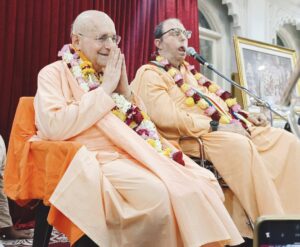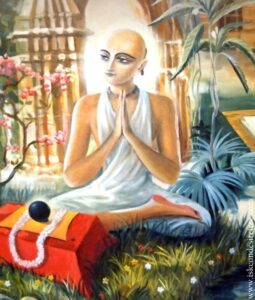Sat-tila Ekadasi is also known as Trisprisha Ekadasi. This Ekadasi occurs in the dark fortnight of the month of Magha (January/February). The glories of Sat-tila Ekadasi are narrated in the Bhavisyottara Purana in a conversation between the sage Dalbhya and Pulastya muni.
This is the third Ekadasi of the year 2024. It is an auspicious start for the rest of the year, and we encourage devotees reading this to kindly consider donating on this day to help complete Lord Nrsimhadeva’s Wing in the TOVP, scheduled to open from February 29 – March 2, 2024. Please go to the Give To Nrsimha Fundraiser page on the TOVP website and select one of several seva opportunity options.
Sri Dalbhya Rishi said to Palastya Muni, “When the spirit soul comes in contact with the material energy, he becomes sinful and performs such heinous acts as stealing, killing, and illicit sex. He may even go to the extent of killing a brahmana.
“O purest of personalities! Please tell me how these unfortunate souls may escape hellish punishments by just simple austerities as offering a little charity.” Pulastya Muni replied, “O fortunate sage, you have asked me an important, confidential question. Please listen very carefully as I reply.
“At the arrival of the month of Magha (January – February), one should carefully control his senses by giving up lust, anger, pride, jealousy, fault-finding, and greed, and meditate on the Supreme Personality of Godhead Lord Sri Krishna. On the day when the constellation of Purvashadha nakshatra arrives, he should bathe, collect some cow dung before it touches the ground and after mixing it with sesame seeds and cotton, prepare 108 balls from it. Then he should strictly observe Magha-krishna Ekadashi as I will now describe.
“After bathing, the aspirant should worship the Supreme Lord. Praying to Lord Sri Krishna by chanting His holy name, he should vow to observe the Ekadashi fast. The devotee should perform an Arati to the Lord – the holder of the conch, disk, club, and lotus – which includes applying sandalwood paste to his feet and offering incense, camphor and a bright ghee lamp. Naivedya (an offering of tasteful food preparations) should then be offered to the Lord. He should keep awake all night and perform a fire sacrifice (homa). The devotee should offer the 108 balls of cow dung, sesame seeds, and cotton wool into the sacrificial fire of the homa while chanting the Purusha-sukta hymns and the Lord’s holy names. He should then offer the Lord pumpkin, coconut, and guava. If these items are unavailable, betel nut may be substituted. Throughout the day and night, the devotee should observe the standard Ekadashi vrata of fasting from all grains and beans.
“The devotee should pray to Lord Sri Janardana, the benefactor of all living beings, thus: ‘O Lord Sri Krishna, You are the most merciful Personality of Godhead and the giver of liberation to the fallen souls. O Lord, we have fallen into the ocean of material existence. Please be kind to us. O lotus-eyed Lord, please accept our humble, affectionate and respectful obeisances. O Supreme Spirit, origin of all forefathers, may You and Srimati Laxmi-devi, Your eternal consort kindly accept our humble offerings.’
“The devotee should then try to please a qualified brahmana with a warm welcome, a pot full of water (purna kumbha), an umbrella, a pair of shoes, and clothes (dhoti, and anga vastra). The devotee should request the brahmana to bestow his blessings for developing unalloyed love of Godhead. If means permit, one must also donate a black cow to the brahmana, particularly if he is well versed in the injunctions of Vedic scripture. One should also offer him a pot of sesame seeds.
“O exalted Dalbhya Muni, black sesame seeds are especially suitable for formal worship and fire sacrifices while white or brown ones are meant to be eaten by a qualified brahmana. One who can arrange to give both kinds of sesame seeds (black and white or brown) on this Sat-tila Ekadashi day will be promoted at least to the heavenly planets after leaving this present body and will live there for as many thousands of years as the number of seeds that would be produced if the seeds he donated were sown in the ground and grew into mature, seed-bearing plants. On this
Ekadashi a faithful person should:
- bathe in the water mixed with sesame seeds,
- rub sesame seed paste on his body,
- offer sesame seeds into the fire in sacrifice,
- eat sesame seeds,
- give sesame seeds away in charity,
- accept charitable gifts of sesame seeds.
These are the six (sat) ways in which sesame seeds (tila) are utilized for spiritual purification on this Ekadashi. Therefore, it is called Sat-tila Ekadashi.”
Palastya Muni continued, “The great Devarishi Narada Muni once asked the Supreme Personality of Godhead, Sri Krishna, about the result one obtains by observing Sat-tila Ekadashi. Lord Krishna replied, ‘O best of the twice born, I shall narrate to you an incident I personally witnessed.
“‘Long ago on earth there lived an old brahmana lady who worshipped Me every day with controlled senses. She faithfully observed many a fast, especially on the days honoring Me (Janmasthami, Rama-navami, Vaman Dwadasi, Nrisimha Chaturdasi, Varaha Dwadasi, Gaura Purnima, etc.) and selflessly served Me with full devotion. Her austerities made her quite emaciated and weak. She gave charity to brahmanas and to young maidens (kanyas), and even planned to give away her house in charity. Yet, although the spiritually minded woman gave charity to worthy people, oddly, she never offered food to the brahmanas or devas (demigods).
“’I reflected about the woman and felt she had purified herself by offering Me strict devotional worship by fasting on all auspicious occasions. She certainly had become eligible to enter My personal abode, which is a rare achievement. So, I came down to this planet to understand her queer behavior. Disguising Myself as a follower of Lord Shiva, complete with a garland of skulls draped around My neck and a begging pot (bhiksha patra) in My hand, I approached her.
“’She said, “O respectful one, please tell me truthfully, why you have come here.” I replied, “O beautiful one, I have come to beg for some alms.” Hearing this, she got angry and threw a lump of mud into My begging pot! O Narada Muni, astonished at the miserliness of this otherwise magnanimous lady, I wordlessly returned to My personal abode.
“’Eventually this austere lady reached the spiritual world without discarding her earthly body. So great was her fasting and charity! I transformed the lump of mud she had offered Me into a beautiful home for her. However, O Narada, this house was just like the mud devoid of any edible grains. It had no furniture or ornamentation, and when she entered it was only a bare structure. She approached Me and said, “I have fasted on so many auspicious occasions, making my body weak and thin. I have worshipped You and prayed to You in so many different ways for You are truly the master and protector of all the universes. Yet despite all this there is no food or wealth to be seen in my new home, O Janardana, please tell me why?”
“‘I replied, “Please return home. The wives of the demigods will pay you a visit out of curiosity to see the new arrival. Do not open your door until they have described to you the glories of Sat-tila Ekadashi.”
“‘The wives of the devas arrived at her home in due course as I had foretold and called out to her, “O beautiful one, we devapatnis have come to see you, please open the door.”
“’The lady replied, “O dear ones, if you want me to open the door, please narrate to me the merit of observing the sacred fast of Sat-tila Ekadashi.” One of the wives beautifully related the sublime nature of this sacred Ekadashi. And when the brahmana lady finally opened her door, they saw that she was not a celestial being like a demigoddess, a Gandharvi, an asuri, or even a Naga-patni. She was just an ordinary human being.
“’The lady observed Sat-tila Ekadashi, which awards both material enjoyment and liberation at the same time. She finally received the beautiful furnishings and grains she had expected for her spiritual home. Her ordinary material body was transformed into a beautiful, spiritual sac-cid-ananda form with a fine complexion. By the grace of Sat-tila Ekadasi, both the lady and her new home in the spiritual world were radiant with gold, silver, jewels, and diamonds.
“’O Narada, a person should not ostentatiously observe Ekadashi out of greed, with the hope of attaining wealth dishonestly. He should selflessly donate sesame seeds, clothes, and food according to his capacity, for by doing so he will achieve good health and exalted spiritual consciousness, birth after birth. Ultimately, he will be released from the bonds of this world (liberation) and granted admittance into the Lord’s supreme abode. That is my opinion, O best of devarishis.’
“O Dalbhya Muni,” Pulastya Rishi concluded, “One who properly observes this wonderful Sat-tila Ekadashi with great faith becomes free of all kinds of poverty – physical, mental, intellectual, social, and spiritual – as well as all kinds of ill luck and evil omens. Indeed, observing this Ekadashi fast by donating, sacrificing, or eating sesame seeds, undoubtedly frees one of all past sins. One need not wonder how this happens. The rare soul who properly performs these acts of charity in the right devotional mood, following the Vedic injunctions, will become free of all sinful reactions and go back home, back to Godhead!”
Thus ends the narration of the glories of Magh-krishna Ekadasi or Sat-tila Ekadasi from the sacred Bhavishya-uttara Purana of Srila Krishna Dwaipayana Vyasa.

 By Vijaya Das
By Vijaya Das











